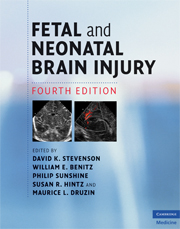Book contents
- Frontmatter
- Contents
- List of contributors
- Foreword
- Preface
- Section 1 Epidemiology, pathophysiology, and pathogenesis of fetal and neonatal brain injury
- 1 Neonatal encephalopathy: epidemiology and overview
- 2 Mechanisms of neurodegeneration and therapeutics in animal models of neonatal hypoxic–ischemic encephalopathy
- 3 Cellular and molecular biology of hypoxic–ischemic encephalopathy
- 4 The pathogenesis of preterm brain injury
- Section 2 Pregnancy, labor, and delivery complications causing brain injury
- Section 3 Diagnosis of the infant with brain injury
- Section 4 Specific conditions associated with fetal and neonatal brain injury
- Section 5 Management of the depressed or neurologically dysfunctional neonate
- Section 6 Assessing outcome of the brain-injured infant
- Index
- Plate section
- References
3 - Cellular and molecular biology of hypoxic–ischemic encephalopathy
from Section 1 - Epidemiology, pathophysiology, and pathogenesis of fetal and neonatal brain injury
Published online by Cambridge University Press: 12 January 2010
- Frontmatter
- Contents
- List of contributors
- Foreword
- Preface
- Section 1 Epidemiology, pathophysiology, and pathogenesis of fetal and neonatal brain injury
- 1 Neonatal encephalopathy: epidemiology and overview
- 2 Mechanisms of neurodegeneration and therapeutics in animal models of neonatal hypoxic–ischemic encephalopathy
- 3 Cellular and molecular biology of hypoxic–ischemic encephalopathy
- 4 The pathogenesis of preterm brain injury
- Section 2 Pregnancy, labor, and delivery complications causing brain injury
- Section 3 Diagnosis of the infant with brain injury
- Section 4 Specific conditions associated with fetal and neonatal brain injury
- Section 5 Management of the depressed or neurologically dysfunctional neonate
- Section 6 Assessing outcome of the brain-injured infant
- Index
- Plate section
- References
Summary
Introduction
The exact timing of hypoxic–ischemic brain injury and the preceding course of events are often unknown, but they play a crucial role in pathogenesis, regional susceptibility, and injury severity in humans, requiring different treatment approaches. The dynamic nature of the developing brain requires the use of age-appropriate models to advance our understanding of both the injurious mechanisms and the means to ameliorate injury.
Several aspects of injury to the immature brain caused by experimental hypoxia–ischemia (HI) or focal stroke in animals have been recently reviewed, including the role of age, blood-flow regulation and energy metabolism, inflammation, intracellular injury mechanisms, and neuronal death, and these will not be covered in great detail here. We will review recently emerging concepts, including the status of the neurovascular unit and blood–brain barrier, neuroinflammation, adaptive intracellular mechanisms, gender differences in the injury response, neuroprotection, and brain repair.
Energy failure and early intracellular injury
The role of disruption of cerebral blood flow and failure of mitochondrial ATP production in initiating injury after HI has been recently reviewed by Vannucci & Vannucci and Perlman. The role of elevated levels of extracellular glutamate, overactivation of excitatory amino acid (EAA) receptors, and calcium (Ca2+i)-mediated intracellular injury, which in part depends on failure of ATP-dependent processes, have been recently reviewed as well.
- Type
- Chapter
- Information
- Fetal and Neonatal Brain Injury , pp. 38 - 47Publisher: Cambridge University PressPrint publication year: 2009



